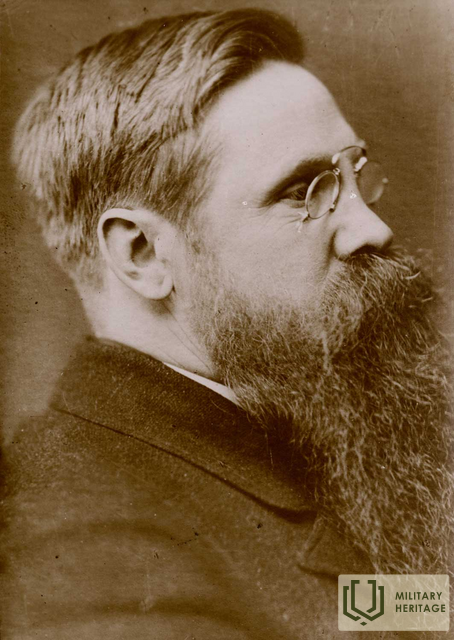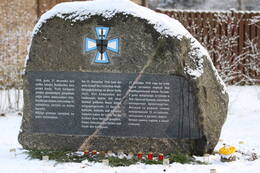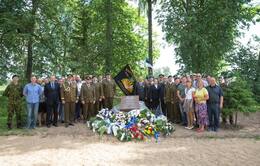Government of Andrievs Niedra
I World War I, I Wars of Independence
The Reed Government was a pro-German Provisional Government of Latvia that existed from May 10 to June 26, 1919, concurrently with the ousted Provisional Government of Kārlis Ulmanis and the LSPR government of Pēteris Stučka.
After the overthrow of Ulmanis' Provisional Government in the April 16 coup, Andrievs Niedra arrived in Liepāja on April 27 as a mediator in negotiations with the putschists' Borkovskis government. At his request, on April 29, the ministers of Ulmanis' cabinet arrested by the Germans were released. The main topic of negotiations between the putschists and the overthrown Provisional Government was the formation of a new compromise government, in which the Baltic Germans, as the economically and militarily most significant part of the Latvian population, would also be represented. Niedra proposed that the Germans publicly condemn the April 16 coup, but the People's Council tasked a new candidate with forming a government that would include 4 ministers from the Ulmanis government, 4 ministers from Niedra's supporters, 3 Germans, and 1 Jew. Ulmanis rejected this offer.
Eventually, on May 10, a new Cabinet of Ministers was formed under the leadership of Andrievs Niedra. The majority of civil servants continued to perform their direct duties, regardless of the composition of the Cabinet of Ministers at any given time. The new government envisaged three basic tasks for its existence: preserving the state, restoring law and order and the economy, expelling the Bolsheviks, holding elections to the Constituent Assembly and establishing a universally elected government.
The Niedra government was in power until the end of June 1919, when, after the defeat in the Battle of Cēsis, at the meeting of the Cabinet of Ministers on June 24, it was decided to turn to the representatives of the Entente and transfer their powers to them. The defeated units of the Latvian National Guard and the German mercenary troops (Iron Division), in accordance with the agreement concluded in Strazdmuiza under the supervision of the Entente countries, evacuated from Riga to Semigallia. After the Strazdmuiza armistice, the units of the troops loyal to the Niedra cabinet, having surrendered their powers to the government, either recognized the legitimacy of the restoration of the Cabinet of Ministers led by K. Ulmanis, or joined the so-called West Russian Volunteer Army.
A.Niedra emigrated after the defeat of the Bermonts and returned to Latvia in 1924, where he was accused of treason. A.Niedra's case as a defendant was heard in two trials in 1924 - separately for the April 16, 1919 coup in Liepāja and separately for participation in Bermont's plans. He was sentenced to prison, which was later replaced by deportation from the country. Niedra moved to East Prussia, where he served as a pastor. In 1942, he returned to Riga, where he died.
More information sources
Wikipedia. Niedra Government. Available: https://lv.wikipedia.org/wiki/Niedras_vald%C4%ABba [accessed 06.05.2021].
Wikipedia. Andrievs Niedra. Available: https://lv.wikipedia.org/wiki/Andrievs_Niedra [accessed 06.05.2021].
Related timeline
Related objects
Monument to the first battle for Latvia's independence
Located in Inčukalns, Atmodas Street 2.
On July 3, 2016, a monument to the first battle for Latvian independence was unveiled, dedicated to the Latvian Landeswehr (Die Lettländische Landeswehr), in which local Baltic Germans, Russians and Latvians, who were in units on both sides at the time, defended the newly founded state against the Bolshevik Red Army. Eižens Upmanis, the chairman of the Brothers' Graves Committee, concluded at the time that this could be the first monument to the combined Latvian and Baltic German forces in battle memorials outside the cemeteries. At that time, Lieutenant Colonel Oskars Kalpaks was appointed commander of the Latvian units of the Latvian Landeswehr, from whose units the later Latvian Army grew and formed during the Freedom Struggle.
In 1918, the entire territory of present-day Latvia had fallen into the hands of the German Empire and its troops. However, in the late summer and autumn of 1918, the situation began to rapidly turn against Germany and it was clear that it was only a matter of time before Germany would be forced to admit defeat in World War I. The Russian Empire, which Latvia was part of until World War I, had ceased to exist earlier, with the February and October revolutions of 1917. On 18 November 1918, the Republic of Latvia was proclaimed. The German army, which was located in the territory of Latvia, after the armistice with the Entente powers on 11 November 1918, was no longer motivated for further hostilities and most of its soldiers simply wanted to return to their homeland.
Under such circumstances, it was clear that the defense of Latvia depended primarily on a national guard formed by the Latvian population itself. Initially, due to their education and relatively greater ability to self-organize, the Baltic Germans living in Latvia showed the greatest initiative in forming such a national guard. Russian soldiers also joined the national guard. In order to ensure the supply of the national guard with uniforms, weapons and other necessary resources, the Latvian Provisional Government concluded an agreement with the German representative Augustus Vinnig on December 7, 1918, providing for the provision of the national guard from the German army reserves located in the territory of Latvia. This agreement indicated, among other things, that this national guard, with the official name “Latvijas zemessardze” or in German – “die Lettländische Landeswehr”, would be the armed forces of the Republic of Latvia.
The Latvian National Guard was confronted by two Latvian Red Riflemen regiments (i.e., approximately 2,000–3,000 soldiers) that had previously been experienced in World War I and the Russian Civil War. Despite the Red Army's experience and numerical superiority, the Latvian National Guard held Inčukalna in fierce battles for two days, until finally, on the evening of January 1, 1919, in order to avoid encirclement, it was forced to retreat, losing 43 killed and several wounded, most of whom were captured by the Bolsheviks, where they were killed or died of hunger or disease.
Author: Artis Buks. Material: Fieldstone. The monument is made of a large monolithic stone that was found in Ruļļi near Jelgava.
Memorial at Skangaļi Manor
The memorial to the victory of the combined Latvian and Estonian troops in the battle for the Skangaļi Manor is located about 20 kilometres from Cēsis. Devoted to the participants of the Battles of Cēsis and the fighters of the Estonian Kalevlaste Maleva Battalion, the memorial stone was unveiled on 22 June 2019. The victory of the combined Latvian and Estonian troops in the battle for the Skangaļi Manor, which took place here, was a turning point in the Battles of Cēsis, as a result of which the troops of Niedra’s government initiated a general retreat. The government of Andrievs Niedra was a provisional pro-German government of Latvia, which existed from 10 May to 26 June 1919. The attack on the Landeswehr unit began in the early morning of 22 June 1919 when the 3rd Kalev company used an armoured train to break into the Skangaļi Manor where they seized 2 cannons, however, the enemy still went on a counterattack. The troops repeated the attack slightly later, in the middle of the day, and the Landeswehr unit was forced out of the Skangaļi Manor following fierce close combat. The trophies from the battle include machine guns, large quantities of ammunition and other combat equipment. Two hours later, the Estonians captured an important road junction at the Starti pub. 58 Kalev soldiers were injured or lost their lives in the battle to capture the Skangaļi Manor. Estonia provided significant support in establishing the memorial site.
Related stories
From Ádolfs Ers' book "Vidzeme in the Struggle for Freedom" about the refugees' journey in Valka
Starting from the time of the refugees, Valka was given a more important role than other cities in Vidzeme, because it was home to the politically active newspaper “Līdums”, where Latvia’s spiritual and political weapons were forged, and also because it was a crossroads where roads from three sides of Latvia converged: from Riga, Alūksne, Mozekile, and also from Estonia and Russia. It had connections with refugees from all sides – Tartu, Pliska, Moscow and St. Petersburg. There was a large refugee center here.








